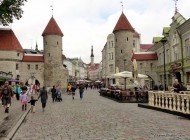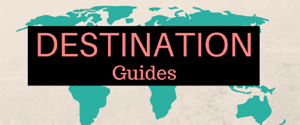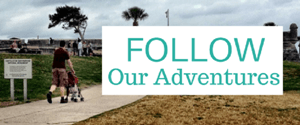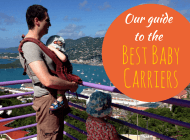Our next stop after Riga was Lithuania’s capital, Vilnius. It’s not a place I knew much about, so I was excited to visit Vilnius and learn more about it. The city certainly delivered, with a good range of attractions, dining and a relaxed atmosphere I loved.
Vilnius is the Baltic States’ second largest city after Riga and has a lot to offer visitors. We were blessed with great weather and discovered that not only is there a lot of things to do in Vilnius, but that Vilnius is great for dining outdoors and being outdoors in general.

It has a great Old Town for just relaxing in the sun as well as exploring. Given Vilnius is not on the coast you’re not fighting day tourists from cruise ships, which makes it even more relaxing for sightseeing. I’d wish we’d been able to stay longer in Vilnius. It was a lot of fun and a great place to explore.
Below you will find everything that we learned about this city – the best things to do in Vilnius, how great Vilnius is with kids, where to stay and eat, how to get to Vilnius, getting around and our budget.
Contents
Top Things To Do In Vilnius
There’s a lot of things to do in Vilnius. There’s a wide range of Vilnius attractions that can make figuring out what to see in Vilnius quite hard if you don’t have much time. Most of Vilnius’ things to do are in and around Old Town Vilnius, with most other attractions near its edge or a short walking distance away.
Vilnius sightseeing could be as short as a day if you focus on the Vilnius Old Town but you’d need at least three days to see even the main attractions.
There’s several kid friendly or kid focused places to visit in Vilnius as well, not to mention some great gardens and parks to run around in. Our kids enjoyed hanging out in Vilnius as much as we did.
Unless otherwise stated, the following Vilnius sites and attractions are in the Old Town.
Gediminas Castle
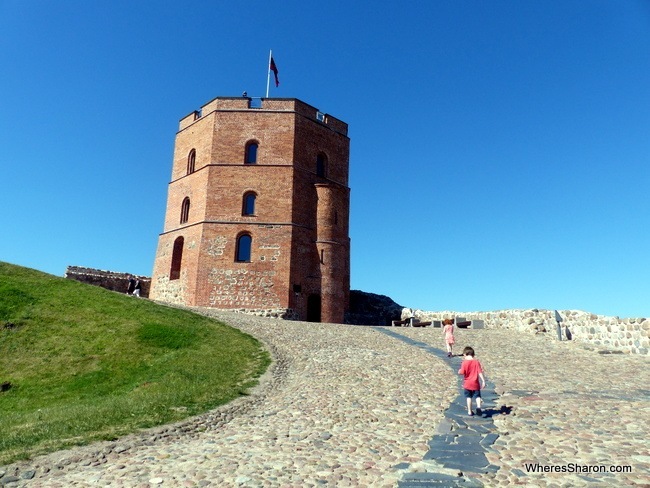
Walking up to Gediminas Tower.
The Gediminas Castle or Tower is perched high on top of the hill and easily visible from a lot of the old town. You can either walk to the top (along a steep, winding, path) or cheat and take the short funicular ride up for 1.5 Euros (1 Euro for kids 7-12), return (there’s a slight discount for going just one way). With our pram, the choice was easy. The funicular can easily accommodate even the largest of strollers.
At the top of the funicular there is a short path to get to the tower itself. Although it stands largely alone the tower was once part of the “Upper” Castle, part of Vilnius’ defenses. The slightly restored ruins of the main keep of the Upper Castle is on the top of the hill too, but you can’t go in.
There’s three levels apart from the ground level. The stairs are not too hard to climb even for young kids, although Z needed some help in climbing down. The views from the top over the Old Town and Central Vilnius are probably the best in the city, which should make it high on your list of what to do in Vilnius. It was one of our favorite Vilnius attractions.
National Museum of Lithuania – New Arsenal
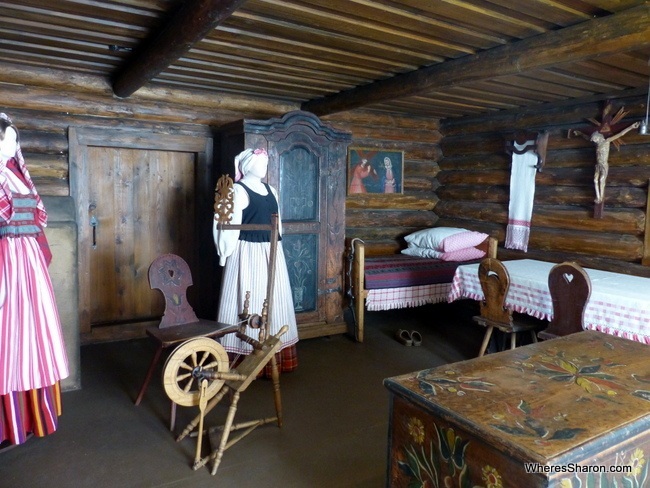
The kids were intrigued by how people used to live long ago in Lithuania.
At the base of the Tower Hill are two old buildings, the New and the Old Arsenals. Each contains a different branch of the National Museum. The Old Arsenal contains exhibits and displays covering Lithuania from prehistoric times to the 13th century. The New Arsenal covers Lithuania from the 13th century up to the modern times.
There’s two levels in the New Arsenal of exhibits, organised into different galleries focusing on a period or aspect of Lithuania’s past. A section with re-creations of rooms from a typical Lithuanian home in past centuries was something the kids found interesting, as was a selection of wooden toys in a gallery on woodwork.
House of Signatories
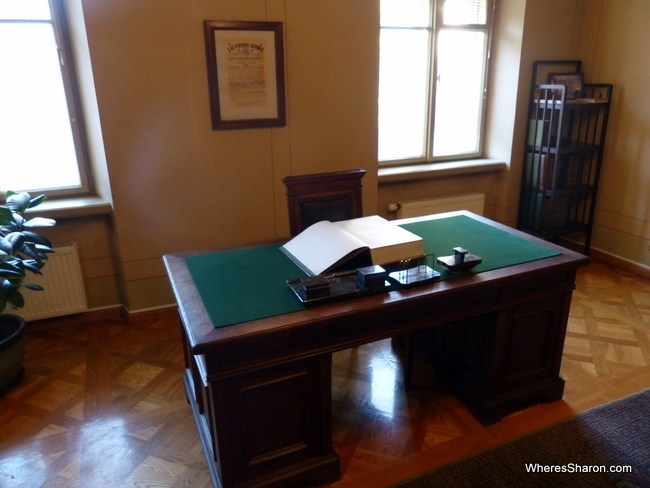
History happened here: where Lithuania’s Act of Independence was signed.
This small museum is actually the preserved house where the Declaration of Lithuanian Independence was signed in February, 1918. From the street, this museum looked like a shop along Pilies gatve and it is easy to miss. An English speaking guide is available for 6 euros, and unless you speak/read Lithuanian this is a good idea to get the most out of this museum.
The museum is quite small, and it is possible you’ll have it all to yourself. Most of the exhibits are photos of Lithuanian independence leaders and their families, plus other bits and pieces. The highlight is the very room – and desk – where Lithuanian independence was signed into existence.
I find it cool to see where a country is “born” but this place is only for the history buffs.
Palace of the Grand Dukes of Lithuania

The main entrance to the palace, off Cathedral Square.
This large palace was built upon the foundations of the lower castle of Vilnius. Over the years it was home to many of the Grand Dukes of Lithuania who were the Lithuanian Heads of State. It is perhaps the largest tourist attraction and one of the most popular places to see in Vilnius.
The entry is down below ground level, and you are guided through the foundations of the palace, along with the complex and rich history of Lithuania explained in snippets as you go along. The next level up contains tonnes of artifacts and displays, from plates to tiles and everything found during archaeological digs and restoration. The next levels are a recreation of the palace around the 16th or 17th century.
The kids found the first levels a bit boring and wanted to run through them. Thanks to Frozen, and its palace interest inducing effect, the recreated palace levels were more interesting for S and Z, and us as well. That said, I could have stayed here for quite some time – there’s a lot to see and read, even if the presentation can be a bit dry. Mobility wise its easy to push a pram around.
Cathedral
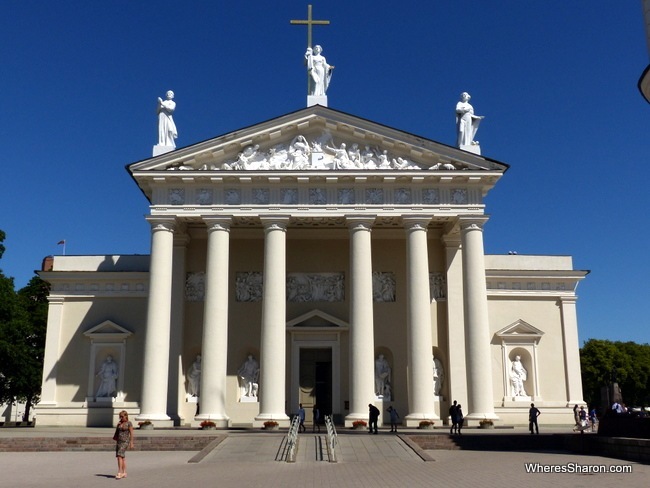
The neo-classical front of the Vilnius Cathedral.
A focal point of the Old Town is the Vilnius Cathedral. It was originally built in the 13th century and has been rebuilt and extended many times since. Although large it looks deceptively simple from the outside. Inside, though, is more impressive with the incredibly high ceiling and rich decorations. Given its focal point, it is a place lots of people start when sightseeing in Vilnius.
To the left of the entrance is the tomb of Lithuania’s only King, Mindaugas. You’re free to walk around everywhere.
S, who is interested in religion, found the Cathedral interesting, and I think it is worth a visit. Entry is free.
Belfry
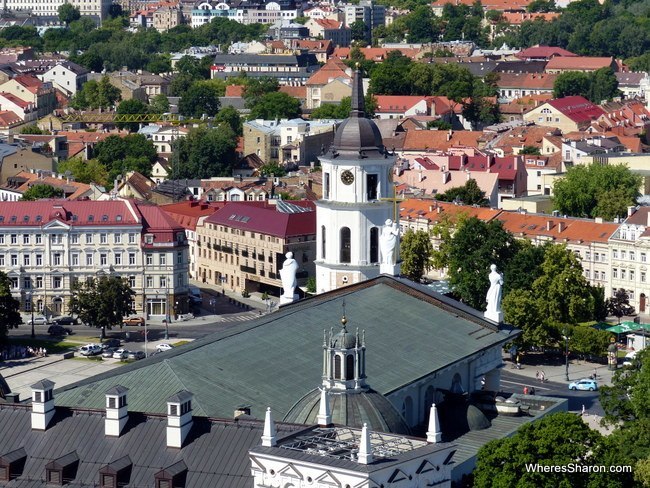
The Belfry as seen from the Tower.
Next to the Cathedral is the Belfry. Going in you have to read over a list of safety regulations before you’re allowed up. The stairs are tough early on but not as bad as others we have experienced in the Baltics. Still, carrying up Z was a challenge. S coped okay.
On the first floor you can control a camera attached to the outside of the tower, panning and zooming as you want. It’s surprisingly fun.
The upper levels let you see up close the bells themselves. Now mechanically activated, rather than manually, its impressive to see them up close. One bell goes off on quarter past the hour, half past and quarter to (and loudly – it scared us). Might not be best to be up there on the hour. That said, the views are quite nice. Between them and the bells it was worth the climb.

Seeing the bells up close was interesting, until they started ringing…
Museum of Genocide Victims

The names of the victims of Soviet oppression carved into the wall.
I decided to go to this museum alone, not wanting to expose the kids to something potentially very dark.
In what was an old court house, and is now a government archival centre, is a building that has tragically been the headquarters of the NKVD/KGB and the Gestapo. It is now a museum documenting the horrors of state oppression and genocide against the people of Lithuania. It’s hard to miss. On the main facade are the names of people who were executed in the basement, etched into the stone itself.
Whereas its Riga counterpart told a simple, emotionally gut-wrenching, narrative, this museum goes into a lot more detail, looking at the increasingly tightening noose of the Soviet State. There was a large section dedicated to the large scale resistance effort after the Soviet reconquest in 1944 (something I knew little about) which lasted until 1953. Plus a lot of information on the methods and effects of Soviet security forces.
The “star attraction” are the cells the KGB (and Gestapo, briefly) used to hold those unfortunates who attracted their attention. Much of the cells are untouched from when they were abandoned, although some have restored to what they were like post World War II, or to the torture chambers they were prior to Glasnost. The cells are quite cold – I’d hate to be there during winter.
There is also the execution chamber – quite literally the room where the post WWII KGB put people to death. Although the details of how people were killed was deliberately never recorded, the preserved bullet holes don’t leave much to the imagination. And just in case, there’s a video with a dramatic no-holes-barred re-enactment playing on a TV in the room.
This museum is certainly memorable. One of the top things to see in Vilnius, as dark as it is.
The Money Museum
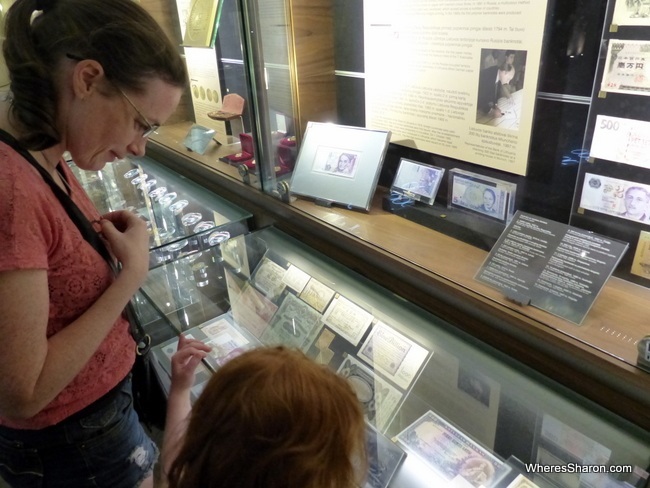
Checking out coins and notes from all over the world.
This small museum is run by the Bank of Lithuania on the side of its headquarters. It’s a small but interesting museum that both the kids and we enjoyed. There’s a lot to see given the museum’s small size.
The museum covers the history of money itself, from bartering to coinage to paper notes. Its done in an engaging way, with simple exhibits and good explanations in English as well as Lithuanian. Some of the exhibits are pretty cool, like what one million coins look like when stacked up in a pyramid. There’s also some hands on and interactive exhibits as well. One of the big attractions is being able to mint your own coin in a big, hand-operated, coin press.
Free audio guides (in various languages) are available and this made things more interesting. Entry is free.
Toy Museum

The kids playing it up, Communist style, on a basketball table.
If the kids hadn’t gotten hungry we may never have left! This museum was great and genuinely had something for all ages.
Like many toy museums there were plenty of toys to play with. However, unlike other places I’ve been to the toys were put into some sort of historical context, with plenty of explanations (in English, too) of the history behind them and their evolution. Often these toys (I learnt) came as imitation of – or training for – the world around them.
The toys kids could play with were often well preserved examples of old (robust) toys made years ago. The displays were set up so the toys went from the oldest (things like spinning tops, toy swords and the like) to more modern toys – ending with a selection of playable Soviet era arcade games from the eighties!
Not that the kids cared about any of the history, they ran off to play with anything and everything before I’d even finished buying tickets. And it was safe for them to run off, too, with just one well watched door, no stairs, and nowhere for the kids to get (too) lost. The museum is not too big but there was plenty to see and do. I was able to look around, at my own relaxed pace.
The biggest hit for all of us were the old arcade games (called slot machines in the East). S and Z loved the foosball style ice hockey games, and I loved the “video” game Naval Battle (where you launch torpedoes from a submarine). The museum even provided genuine 80s USSR 15 kopeck coins to play! It was no Double Dragon but I’m sure it sucked in many a ruble back in the day. Every parent played it, I suspect many were reliving their youth having played it way back when…
This is a small museum with a lot of fun. Young kids could spend many hours here. It should definitely be on your Vilnius what to do list if you have kids.
Radvila Palace Museum (part of the Lithuanian Art Museum)

S and Z watch a video on some aspect of the collection.
This small art museum is housed in what was a wing of a large private palace of Duke Jonusas Radvila. It contains the foreign art collection of the Lithuanian Art Museum.
The collection isn’t huge, which is just as well as S and Z weren’t very interested, despite our best efforts. Even though it’s not for kids there’s some cool art to see, like freezes from the Parthenon and works by Flemish masters. If you have an interest in art its worth a look.
Energy and Technology Museum

One of the many science based kids activities – this one explains energy waves.
Located north of the Old Town, the Technology Museum is housed in what was Lithuania’s first electrical plant, built and operating from 1903 till 1982. The first three levels (including the basement) are dedicated to its history as a power plant, with the boilers (some of which dating back prior to WWII), turbines, and control panels in place.
There’s free wifi throughout the museum, which you can use to download an audio tour to your phone/tablet/laptop which adds to the brief English captions on the technology. The kids enjoyed sitting at the controls managing the power station but the real action for them was upstairs.
On level 2, there is a display of things made in Vilnius and the history of local industries. Not so interesting for the kids but for someone who thought that Communism couldn’t make anything decent, I was impressed by the electronics and space-age looking vacuums that were built back then.
Levels 3 had more hands on displays of various traditional Lithuanian industries (textiles, glass manufacture, and printing – S loved typesetting her name) plus a small but highly engaging kids area with various science-based activities. Each one explained the nifty scientific principles it was demonstrating. On level four there were even more hands on activities. Between the two levels two hours flew by quickly. It was one of the top things to do in Vilnius as a family.
Railway Museum
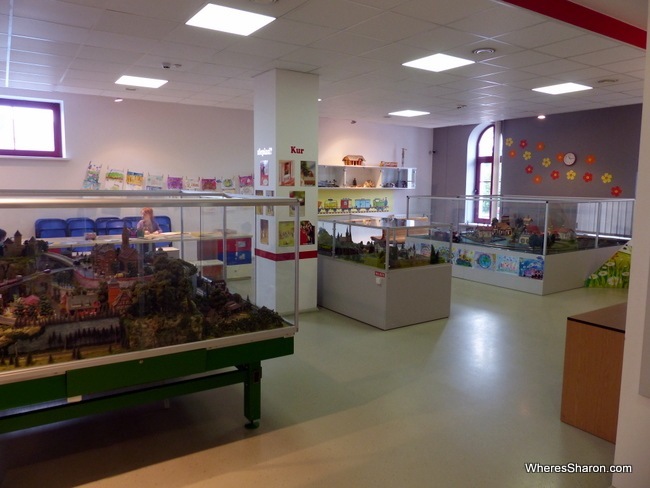
The kids area at the Railway Museum.
The Railway Museum of Vilnius is located inside the main terminal building of Vilnius’ Central Station. Look for a marked door to your right as you enter the terminal, then proceed up two flights of stairs (there’s a lift but you need someone to activate it for you) to find it.
The museum is small, but it has an interesting collection of railway artifacts and displays. The exhibits are captioned in English as well as Lithuanian but the main text outlining the history of Lithuanian railways was not, so it was hard to take too much out of it.
To the rear of the main display hall is a kids area that S and Z loved, with books, somewhere to colour in train-related pictures, wooden trains to play with and some high class model train displays. The displays had things you could look for, like a purple cow, or a couple getting married, like some big Where’s Wally/Waldo which S and I enjoyed.
There was a small theater near the entrance showing some claymation safety ads that were surprisingly entertaining given they weren’t even subtitled.
There’s an outdoor exhibit area with real trains to explore, but it is only open from 13:00 in the summer months, and we were too early. Despite missing out on the main draw-card we were entertained for an hour or so.
The museum is easy to get to as almost all of the city’s bus and trolley-bus routes go to or from the station.
Bernardine Park

Vilnius has some great open spaces and parks in and around the Old Town. Perhaps the best of these was Bernardine Park.
With St. Anne’s Church in the background Bernardine Park was a huge open space with lovely laid out gardens, plenty of grass to run around on, and lots of shade. There’s a restaurant and kiosks in the confines of the garden but it would be a great place to have a picnic and let any kids run around. There’s no charge to get in.
If you’re exhausted from Vilnius sightseeing and are wondering what to do in Vilnius to relax you could do worse to visit Bernardine Park or one of the many great open spaces in Vilnius.
Vilnius Card
We used a Vilnius Card to get access to just about all the attractions listed on this page. The card has an additional option that provides free access to public transport for a chosen period (cards can be valid for 24, 48 or 72 hours). When you buy the card you are given a book with vouchers for all of the places you can go see for free, as well as a whole set of discounts for activities, bars and restaurants.
Included in the card is a free Old Town walking tour – which sadly we could not make use of – and if you get the 72 hour card you can get an audio guide on free loan as well.
The Vilnius card made our visit much easier. We love not needing to worry about how to buy a ticket on public transport and being able to walk up to all of the main attractions without worrying about the cost encouraged us to get out and see more. We did not get a card for the kids – they were free on public transport and only the Toy Museum required paying an entry fee for kids under seven.
You can find more information on the excellent Vilnius Tourism site.
Accommodation in Vilnius
While there are lots of hotels in Vilnius, we chose to stay in an apartment we rented off Airbnb in a great location in the Old Town. This allowed us to have more space than a hotel room as well as prepare some meals. There were also the benefits of having free wifi as well as a washing machine – no small luxury when laundromats can be hard to find.
If you are not an Airbnb member yet, you should be! This service is great and is how we are managing to travel in Europe on such a small budget. We would love it if you could sign up with our link, then we both get US$25 off our next rental. You can view the apartment where we stayed here – we recommend it.
If you’re looking at hotels, Vilnius Old Town has many to choose from. Many others are also located in the city centre close by.
Where to Eat: Good Restaurants In Vilnius

Enjoying outdoors dining at Savas Kampas.
If you are after top restaurants with great value then Vilnius is a great place to go. Unlike previous cities, it seemed like almost all of the restaurants we looked at were in our budget and we didn’t have a bad meal. Many restaurants in Vilnius seemed to offer great dishes at around 5 Euros. The value was fantastic – eating out should definitely be on your list of things to do in Vilnius.
What was great about many of the restaurants was the option of eating outdoors. Obviously being summer and having great weather helped, but it seemed lots of places allowed you to eat outside. This was great for the kids as they could run around a bit while waiting for our meals, instead of being stuck sitting at the table. Places offering outdoor eating were the best restaurants in Vilnius for us.
Small supermarkets are spread out across Central Vilnius making it easy to self cater.
Here’s the restaurants in Vilnius that we enjoyed:
Spyros Metaxas
A small Greek restaurant on the busy, touristy, Pilies gatve, near Cathedral Square. It had some nice sandwiches and Sharon had a great vegetarian fried Potato dish. Great for people watching.
Konstantino Sirvydo Skveras
An entirely outdoor venue, near a playground as part of the plaza opposite Saint Parasceve Orthodox Church, where Pilies gatve splits into two at it’s southern end. The mainstay food here is cheap Lithuanian “pizzas” – Georgian cheese (and other toppings) baked on flat breads. Really tasty, especially with the cheap but good beers.
Boksto Vartai

Now that’s a “cheeseburger!”
Just round the corner from where were staying on Boksto gatve was a place serving good pizzas and burgers, and beers at great prices. The highlight for us was the “vegetarian” burger which replaced the patty with an equivalent sized thick piece of Camembert cheese. Somehow it works. The kids got paper and textas to play with when we entered, too.
Savas Kampas
On Vokiečių Gatve, where there are several outdoor eating places, we found this place with some great dishes for around five Euros on the promenade. This place (and the others around it) were packed on week nights, but even at 7pm was strangely quiet on the weekend when we went. It’s a lovely venue, even for just a drink.
Budget
We spent an average of 80 Euros a day in Vilnius. Our costs were low due to our apartment, and a little bit of self catering (especially for breakfast). However, we generally ate and drank where and what we wanted, thanks to the excellent value of Vilnius restaurants.
Getting Around and Vilnius Public Transport
Due to its small size and (largely) decent footpaths it is easy to get around the Old Town and Central Vilnius on foot. It was generally easy to get around with a stroller and for young kids to walk.
Public transport is easy to find in the centre of Vilnius, outside of the Old Town. Buses and trolley buses run frequently during the week. Most routes seem to leave from the main train station and the bus station Vilnius, which together form the main hub of Vilnius transportation. You can buy tickets in advance but we found it easy to buy a single trip ticket for a Euro on a bus/trolley-bus directly from the driver. The Vilnius Card provides free public transport for the length of your card.
During the week buses and trolley buses were crowded, which made getting a stroller on and off hard, but people were very good in helping S and Z to get a seat and on and off.
For more information on they city’s public transport Vilnius’ tourism office has a good page of information including links to route maps.
Getting a taxi in Vilnius can be a costly affair. Taxis in Vilnius can set their own tariffs and anecdotal reports indicate many people have been overcharged. Locals, reportedly, book a taxi from a taxi company rather than hail a taxi on the street. Our one experience using taxis backed this up. Our driver was only too happy to use the meter after setting it to the highest rate.
Getting to and from Vilnius

Working on our Lux Express journey to Vilnius
Because of Vilnius’ position, buses tend to be the most convenient option for getting to and from Vilnius overland. To get to Vilnius we travelled overland by bus from Riga, Lativa, on Lux Express. We then travelled on to Warsaw, Poland, on a Polski line bus. Lux Express also cover this journey.
There are lots of flights to Vilnius from cities across Europe. Vilnius flights will land at Vilnius International Airport, which is very close to Vilnius Old Town, just 6km away.
Bus from Riga to Vilnius
Our Lux Express bus took four and a half hours. It was incredibly comfortable, with big spacious seats. The trip flew by with in seat, on demand entertainment, power and even wifi! There was even a hot drinks machine which we could use for free. The hot chocolates are awesome.
Bus from Vilnius to Warsaw
There is no direct Vilnius-Warsaw train at the moment, so bus is the only option to travel from Vilnius to Warsaw. We traveled on a Polski Bus, a journey which took eight and a half hours, including a stop in Bialystok.
Read more about getting around the Baltics here.
Vilnius for Kids
Our kids had a great time in Vilnius. There were some great attractions the kids loved: the Railway Museum, the Money Museum and the Energy and Technology Museum were all big hits. The Toy Museum was in another league altogether (it might be our favorite place in the Baltics!).
Just as good as the attractions was the open space we could enjoy. Both central Vilnius and the Old Town had several small parks and playgrounds that helped break up the site-seeing. The large park next to the Cathedral Square/Grand Duke’s Palace and Bernardine Park were great places to hang out while the kids played and ran around.
Best of all were Vilnius’ many plazas and open space that also had places to eat, which made the meals much more relaxing. These spaces made it much nicer to hang out around Vilnius as the kids weren’t always cooped up inside.
There’s also a range of indoor play centres and Vilnius activities for kids we didn’t get to check out: the Vilnius Tourism Office has a list.
Our Verdict
We really enjoyed our stay in Vilnius. The Old Town, and the centre of Vilnius are nice and compact and easy to get around. There is a lot to see and do. Some of the attractions like the Toy Museum or the Genocide Museum we’ll remember for some time.
For times when you don’t want to see or do anything, there are plenty of great spots to sit and relax. We could have spent longer checking out the sites and hanging out and chilling, especially with the good weather we had.
Vilnius is a beautiful place to spend a while to visit and relax. Like Riga, we would love to return and spend a while. Everything seemed easy, there were some great kid attractions and the restaurants we tried served some really good food (and drinks) at affordable prices.
Vilnius, we will be back!
Tags: Lithuania Travel Blog





